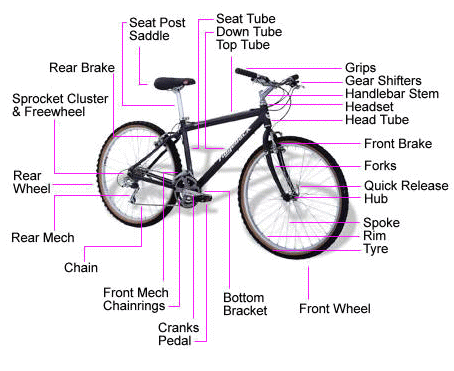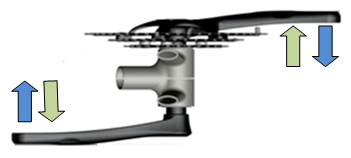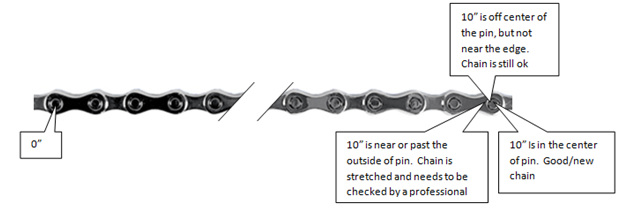Is it time to tune your bike?
by Adelaide Z | August 3, 2010Tips on what to check to see if your bike is in need of a tune-up
Like all mechanical devices, regular maintenance will help to ensure bike will run smoothly for decades. Just as neglect can see even the most expensive bike wear out in less than a season. Below is a series of simple things to check without the need for any tools (short of a ruler).

Brakes
- Check that your brakes are tight enough by depressing both brake levers. If you are capable of squeezing either/both lever far enough that it touches the handlebars, your brakes are too loose and they need to be tightened.
- Make sure your brake pads are properly aligned to your rims (does not apply if you have disk breaks). Watch your brakes open and close as you engage the breaks. Do the brake pads on both sides of the wheel touch the rim at approximately the same time? Is your break pad touching the center of the rim? Unless you answered ‘yes’ to both of these questions, your brakes need adjusting.
Wheels
- With the wheel off the ground, give it a good spin and watch the rim at its closest point to your brakes. If you see the space between the rim and the break getting bigger and smaller, it may be time to have your wheel trued (the act of making the wheel straight). If the wheel spins without rubbing on the breaks, then it’s only slightly out of adjustment and can be safely ridden. However, if it rubs against the brakes on one or both sides of the wheel, it needs to be trued.
- When the wheel is spinning it should not generate any vibrations in the bike. If it does or when it’s spinning you notice that is slows down quickly, the hub is too tight and needs to be adjusted.
- With your bike in a standing position, firmly grip the tire and try to wiggle the wheel from side to side. If you feel it rocking back and forth or any looseness, your hub is too loose and needs to be adjusted.
Headset
- Apply the front break tightly and rock the bike back and forth. If you feel anything loose or shaking, your headset is too loose and needs to be tightened.
- While the front wheel is off the ground, grab the stem at its lowest point (just above the headset) and gently turn the wheel fully to the left, fully to the right and repeat a few times. If you feel any roughness, resistance or stiffness, the headset is too tight and needs to be loosened.
Bottom Bracket
- Shift the front derailleur to the lowest/smallest gear and with a rag/cloth/paper towel/etc… pull the chain off the smallest gear and let it hang on the bottom bracket. Grab the crank arm at point it’s connected to the bottom bracket and slowly rotate the crank arm around. If you feel any roughness or resistance (should spin freely), the bottom bracket is too tight and needs to be loosened.
- With the chain still off, grab both crank arms near the pedals and wiggle them back in forth in unison (push the Crank Arms in the direction of the blue arrows, then the green & repeat several times). If the Crank Arms shake around at all, the Bottom Bracket is too loose and needs tightening.

Chain
- As you use your bike, the chain will slowly stretch (a well lubricated chain stretches much slower). A certain amount of stretching is ok, but if your chain stretches too far it will wear out other components and when it comes time to change the chain you’ll have no choice but to replace the components that wore out due to this stretched chain. To check if the chain has stretched, take an imperial ruler and place the zero mark in the center of one of the pins in the chain. Measure out 10” and if your chain is in new or near new condition the 10” mark will fall in the center of another pin. If it falls off center of the pin but not near the edge, your chain has stretched but still has some life left in it. If it’s near the edge of the pin, bring your bike to a professional so to be accessed. If the 10” mark is outside the pin, your chain is badly stretched and further components will need to be changed along with your chain.

Shifters and Derailleur
- While slowly riding the bike, shift through all the gears one at a time. After each shift does the chain move to another gear? If it doesn’t shift, falls off the gears, takes a few moments to shift or makes a continuous clicking noise before/after the shift, the derailleur(s) need to be adjusted.
Like all mechanical devices, with proper maintenance, the majority of the mechanical components of your bicycle will last you a life time. But left unattended a component that’s too tight or too loose will wear out, cost more in repairs, reduce the efficiency of your bike and diminish the smoothness of your ride.
Although these simple tests are a good indicator or the condition of your bike, many of the components can only be conclusively diagnosed through some level of disassembly of your bike. Therefore it is always recommended to get your bike a full tuned-up (avoid the basic tune-up that adjusts your brakes and shifters/derailleur alone) at the beginning of each season.
Be sure to regularly lubricate your chain and keep your tires inflated to the pressure marked on the tire sidewalls.